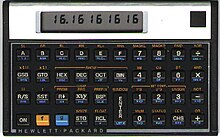HP-16C

HP-16C
|
|
| Type | Programmable, Computer science |
|---|---|
| Manufacturer | Hewlett-Packard |
| Introduced | 1982 |
| Discontinued | 1989 |
| Cost | 150 USD (1982) - 120 USD (1989) |
| Calculator | |
| Entry mode | RPN |
| Display type | LCD seven-segment display |
| Display size | 10 digits |
| CPU | |
| Processor | HP Nut |
| Programming | |
| Programming language(s) | Keystroke programming (fully merged) |
| Memory register | 203 bytes (shared with programs) |
| Program steps | up to 203 steps (shared with data registers) |
| Other | |
| Power supply | 3× LR44 1.5 V button cells |
| Power consumption | 0.25 mW |
| Weight | 113 g |
| Dimensions | 128 × 79 × 15 mm |
The HP-16C Computer Scientist is a programmable pocket calculator that was produced by Hewlett-Packard between 1982 and 1989. It was specifically designed for use by computer programmers, to assist in debugging. It is a member of the HP Voyager series of programmable calculators. It was the only programmer's calculator ever produced by HP, though many later HP calculators have incorporated most of the 16C's functions.
The 16C can display integers in hexadecimal, decimal, octal and binary, and convert numbers from one number base to another. It also deals with floating-point decimal numbers. To accommodate long integers, the display can be 'windowed' by shifting it left and right. For consistency with the computer the programmer is working with, the word size can be set to different values from 1 to 64 bits. Binary-arithmetic operations can be performed as unsigned, one's complement, or two's complement operations. This allows the calculator to emulate the programmer's computer. A number of specialized functions are provided to assist the programmer, including left- and right-shifting, masking, and bitwise logical operations.
Apart from programmer functions, the calculator's abilities are limited to basic arithmetic (and reciprocal and square root), which meant that typical users would also make use of a general scientific calculator. Floating-point numbers are only supported for base 10. However, it is still far more powerful (though also much more expensive) than contemporary competitors such as the non-programmable computer math calculator Casio CM-100 or the TI Programmer,LCD Programmer or Programmer II.
...
Wikipedia
